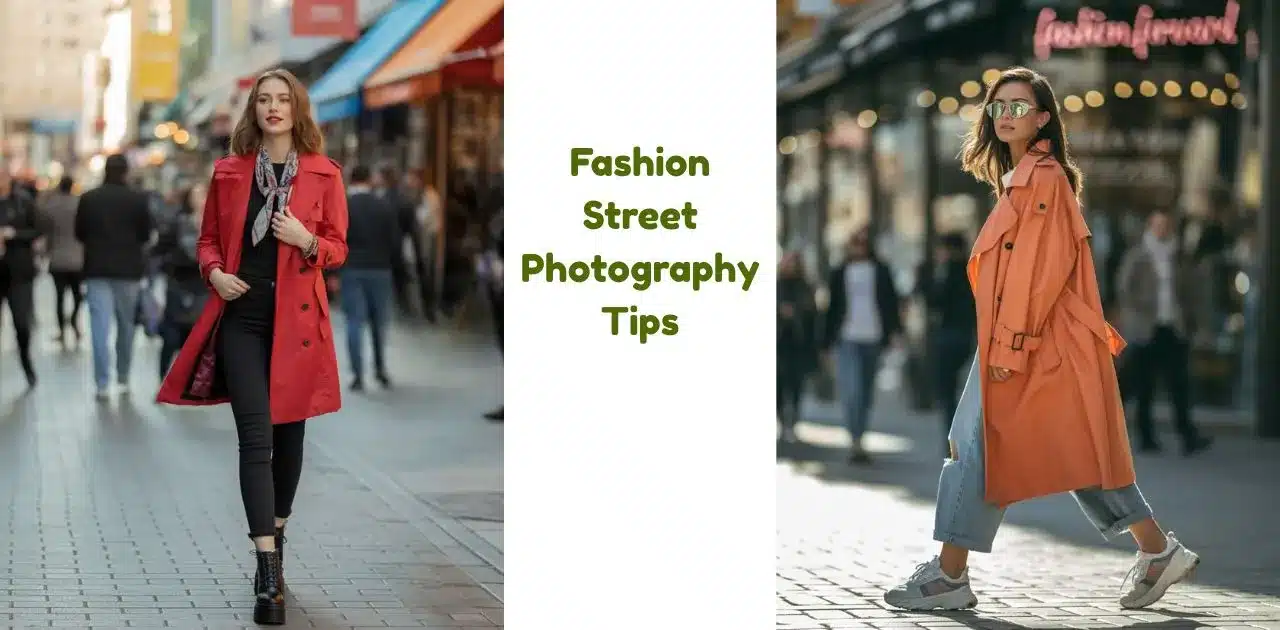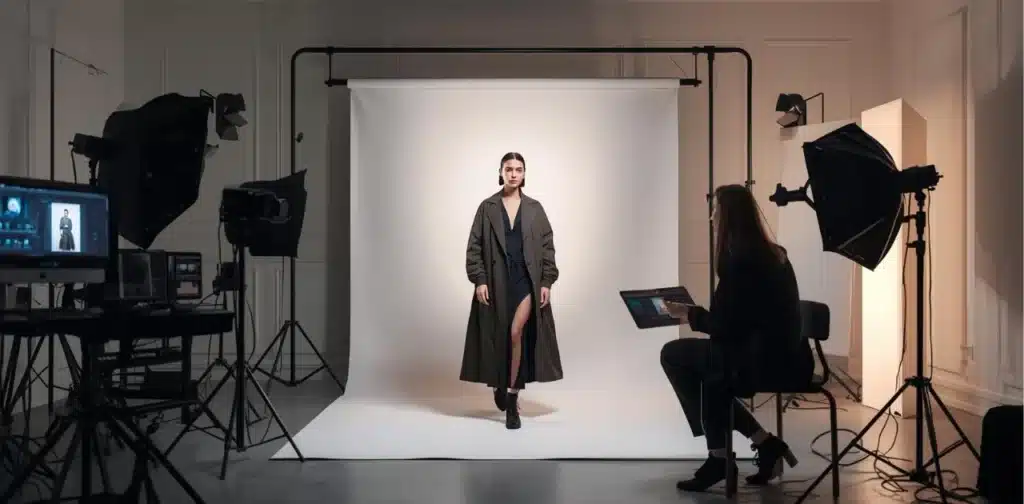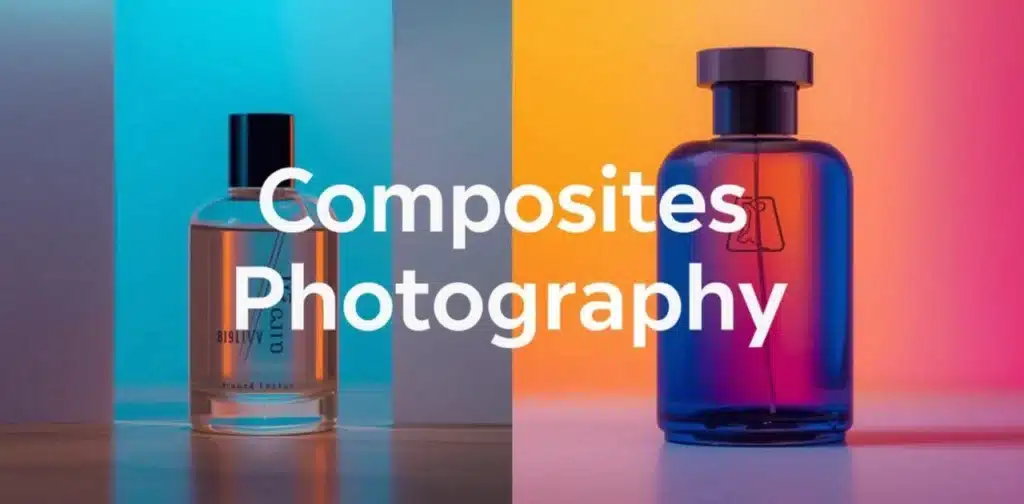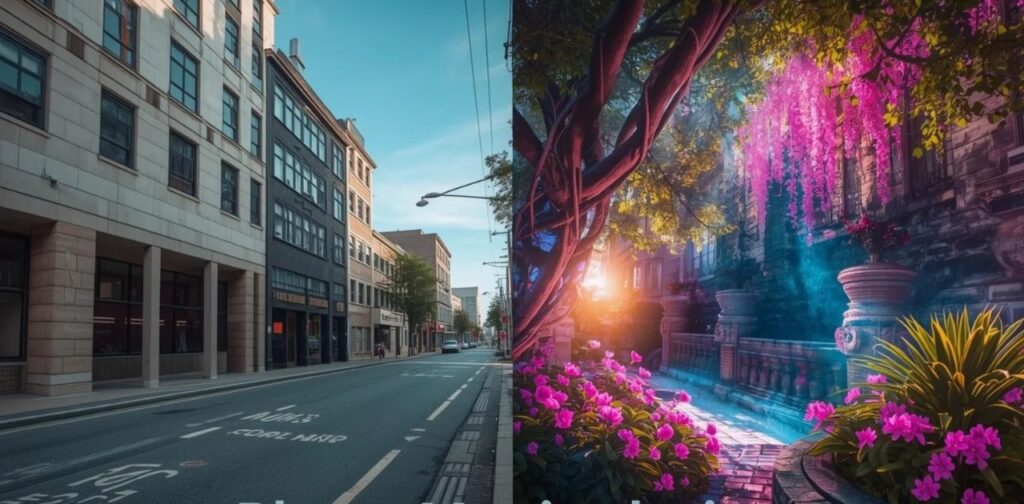Fashion street photography means taking pictures of real people in cool clothes, out on the street. It shows style in action, not in a studio. You don’t need fancy lights or gear. Just a good eye and the right moment.
It’s loved because it feels real. These tips will help you snap great shots, even in busy spots. I’ve seen amazing looks on sidewalks and street corners. Some of my best shots came by luck. Want to take photos that pop? Let’s go!
What Is Fashion Street Photography?
Fashion street photography means capturing real people wearing stylish clothes in everyday places. It’s not about perfect lighting or planned poses. It’s about the raw, real feel of fashion as it happens—on the move, in the city, under sunlight or street lamps. This style blends fashion with everyday life, where the sidewalk becomes your runway.
The roots of this genre go back to icons like Bill Cunningham, who was often seen riding his bike around New York, snapping photos of strangers with great style. His work felt honest and full of joy. Later, Scott Schuman, better known as The Sartorialist, gave this candid style a digital twist. He showed how everyday people could inspire fashion trends without needing a magazine cover. Their work gave life to what we now call urban fashion photography.
Essential Gear for Street Fashion Shoots
Street fashion photography needs gear that’s light, fast, and reliable. You’re often moving around, chasing perfect light or spontaneous style moments, so having the right setup makes a big difference. Whether you’re walking through a busy street or ducking into a quiet alley for that golden shot, your tools should help you, not hold you back.
Mirrorless or DSLR—Which One’s Better?
Both camera types work well, but mirrorless cameras are usually lighter and quieter. That helps a lot in street situations where you want to stay unnoticed. DSLRs, on the other hand, offer great battery life and a solid grip, which can be useful if you’re shooting for hours. I used a DSLR for years before switching to mirrorless, and the weight difference felt like a breath of fresh air—especially during long shoots in city heat.
Lenses That Make Your Style Pop
A 50mm f/1.8 lens is one of the best choices for fashion street portraits. It gives you a natural field of view, sharp images, and dreamy background blur. I’ve also used a 35mm lens when I wanted to include more of the city vibe in the shot. It brings out the scene while keeping the focus on the outfit. Some pros swear by the 85mm lens for portraits, but it can be a bit tight in crowded streets.
Accessories You Shouldn’t Forget
A comfortable strap will save your neck. Trust me, I’ve learned this the hard way. An external flash helps in low light, but make sure it’s compact. Extra batteries are a must—nothing kills a shoot like a dead camera. I always carry at least two. If you shoot in hot weather, a small microfiber cloth can be a lifesaver for cleaning your lens or sweaty hands. The best camera for street fashion photography isn’t just about the body—it’s about the full setup that supports your flow.
Good gear doesn’t have to mean expensive. It means gear that fits your style and pace. Ask yourself—does your camera make you want to shoot more, or does it slow you down? Once you’ve got a setup that feels like an extension of your hand, everything else just clicks into place.
Scouting the Perfect Location for Fashion Photography
A good background can make a simple outfit stand out. In fashion street photography, the place matters as much as the clothes. I love walking through the city with my camera. I let the streets lead me. My best shots often come from alleys with graffiti, old doors, or sunny sidewalks.
City scenes add style. Look for bold walls, cool textures, or strong lines. Brick walls, subway stairs, or small cafés can bring charm. These spots add mood but don’t take over. Great locations don’t shout. They let the outfit speak.
To keep things clean, check the space before you shoot. Watch out for clutter—like cars, signs, or people. I often wait a bit or move my angle. You don’t need a fancy spot. Just one with good light and simple lines.
Styling Tips for Street Shoots
Work With People Who Know Style
In fashion street photography, the person you photograph matters just as much as the outfit. Working with people who already understand how to carry themselves, like fashionistas, models, or even local influencers, can instantly improve your shots. They know how to pose, move naturally, and express their style with confidence. But you don’t need to know a famous model to get a great photo. Some of my favorite street portraits came from quick chats with strangers. A friendly compliment like, “Love your outfit—can I snap a photo?” goes a long way. Most people are flattered and happy to take part. They bring their own flair, and you capture something real.
Clothes That Catch the Eye (But Don’t Scream)
The best street fashion photos aren’t about high-end labels or runway looks. They’re about outfits that feel true to the person wearing them. A well-styled look should draw attention, but not in a way that overwhelms the scene. Layering adds personality—like a denim jacket over a hoodie, or a scarf thrown casually around the neck. These small details create depth and movement. Sharp lines from structured clothing bring edge and confidence, while loose or flowing fabrics add softness and motion. From my own shoots, I’ve learned that outfits with just the right amount of detail—like rolled sleeves or bold buttons—often make the biggest visual impact.
Use of Color, Texture, and Detail
Color and texture can make or break a photo. Bright, clean colors like red, cobalt blue, or mustard yellow pop in urban environments. Earth tones like olive, brown, and beige create warmth and a natural vibe. Texture adds another layer of emotion—think soft wool, worn denim, or shiny leather. These surfaces bring life to the image, even before editing. I remember capturing a woman in an all-white outfit walking past a concrete wall. Her look lit up the entire frame, simply because of how clean and crisp the contrast was. Patterns can work too—like subtle stripes or floral prints, but they should never compete with the background.
Working with Natural Light
Light is everything in fashion street photography. The way it hits the face, the clothes, and the background can make or break a shot. And the best part? Natural light is free. You just need to know how to use it.
The Best Time to Shoot Outside
Want soft, flattering light? Shoot during the golden hours. That’s early morning just after sunrise, or late afternoon just before sunset. The light is low, warm, and gentle. It wraps around your subject and gives skin a soft glow. I’ve shot in the middle of the day and during golden hour—and trust me, the difference is night and day.
If you can’t shoot at those times, try finding shade. Open shade, like the side of a building or under a tree, gives even light and cuts down harsh lines on the face. I once snapped a great street portrait near a café at noon. The roof cast just enough shade to soften the shot, and it turned out great.
Using Shadows and Highlights in a Smart Way
Don’t be afraid of shadows. They add mood, shape, and depth. A hat casting a shadow across the face, or sunlight slipping through blinds onto a jacket—it all tells a story. Try placing your subject near a wall where light hits at an angle. You’ll see strong lines and cool shapes form. Highlights can bring out texture in clothes, while shadows shape the body and face.
In one shoot, I found a sidewalk where sunlight came through a metal gate. The lines of light and shadow made the scene look like art. And it was all natural. No filters, no flash—just good timing.
What to Do in Overcast or Harsh Sun
Cloudy days are a gift. The sky acts like a giant softbox, giving you smooth, even light with no hard shadows. It’s one of my favorite times to shoot, especially for portraits. Colors pop better, and the light feels calm. Reds, greens, and yellows seem to glow on camera.
But bright sunlight can be tricky. When the sun is high, it can cast strong shadows under the eyes or nose. Faces may look too sharp, and details in clothes can get lost. In that case, I try to find a spot with shade, like the side of a building or under a wide tree. Turning the model so the sun hits from the side instead of from above also helps shape the face in a softer way. Sometimes, I’ll use a building to block part of the light and create balance in the frame. These little changes make a big difference.
Composition Techniques That Work
Great outfits deserve great framing. Composition is what makes your street fashion portraits stand out. It turns quick street moments into images people remember. These techniques are simple, but they create big impact.
Use the Rule of Thirds to Guide the Eye
Imagine your frame divided into nine equal boxes, like a tic-tac-toe grid. Placing your subject at the intersections—not dead center—gives your photo a more balanced, natural feel. It’s a small shift, but it draws the viewer’s eye right where it needs to go.
Let Lines Lead the Way
City streets are full of lines—sidewalks, fences, building edges. Use these as leading lines to guide the viewer toward your subject. I once captured a model walking along a painted crosswalk, and those stripes did half the work for me. They pulled everything together and added flow.
Make the Most of Symmetry
Some scenes are made for symmetry. Think of tall doors, matching windows, or even clean reflections in water. Place your subject right in the middle, and the shot feels calm and structured. It’s a smart way to bring order into a busy street scene.
Catch the Movement and the Moment
Candid energy is what gives fashion street photography its soul. Try snapping while your subject walks, spins, or laughs. A flying jacket, a swaying bag, or a sudden smile can turn a simple photo into a story. Don’t wait for stillness—shoot in motion.
Frame Your Subject Naturally
Framing isn’t just for paintings. You can use real-world shapes—like arches, windows, tree branches, or even shadows—to frame your subject. It adds depth, draws focus, and makes your image feel complete. These tiny touches often make a big difference.
How to Approach and Photograph Strangers
Street fashion photography isn’t just about style—it’s also about people. Real people. And that means stepping out of your comfort zone sometimes. Whether you’re snapping someone in a bold outfit or a casual look that just works, you’ve got to find the right way to approach them without making it weird or awkward.
Ask Without Killing the Moment
Have you ever spotted someone with amazing style but hesitated to take the shot? Yeah, me too. You don’t want to ruin the vibe, but you also don’t want to miss it. The trick? Be quick, honest, and kind.
Say something simple like, “You look incredible—can I take a quick photo for a fashion project?” Keep it short and friendly. Smile. Most people appreciate the compliment. You’ll be surprised how often they say yes.
Sometimes, I don’t even ask right away. I strike up a small chat first—“Love those boots!”—and wait for the moment to feel right. That little bit of connection goes a long way.
Catch Candid Moments Without Being Creepy
Not every great photo comes with a conversation. Some of the best shots are unposed, caught mid-step or mid-laugh. If you’re going for that true candid style, keep a respectful distance. Don’t lurk or stare through your lens like you’re on a wildlife safari.
Instead, blend in. Move naturally. Use a silent shutter if your camera allows it. I usually stay just far enough that I’m not in their personal bubble, but close enough to capture the details. Think of yourself as part of the street, not a spy hiding behind a bench.
Respect the Lines, Ethically and Legally
Some countries or cities have strict rules about street photography. Others are more relaxed. In places like New York or Paris, you can usually photograph people in public without needing a permit, but that doesn’t mean you should ignore their comfort.
Ask yourself: Would I be okay being photographed in this situation? If not, don’t do it.
And always avoid taking photos of kids or vulnerable people unless you have clear permission. That’s a hard no in most cases. The street is public, yes—but dignity and respect still matter.
Post-Processing Tips for Street fashion photography
Editing helps make your photos pop. Once you take the shot, the next step is to polish it. You don’t need to overdo it. Just a few small changes can make a big difference.
Lightroom and Photoshop are great tools for editing. Lightroom is best for light and color. Photoshop works well for fixing skin and clothes. At SR Clipping, we use both. We clean up the photo while keeping it real. That means smooth skin, clean clothes, and rich color, without looking fake.
Color can change the whole mood. Some photos look great in soft, warm tones. Others need bold colors to stand out. A popular look is soft brown and gray for a classic style. At SR Clipping, we match the style you want. We make sure faces look real and colors stay true.
Good photo editing keeps the street vibe. We don’t erase the small things that make a photo feel real. Our team at SR Clipping does light skin fixes and smooths out clothes, but we never make the person look plastic. A clean photo should still feel like life.
If you want your photos to shine, good editing is key. You can do it yourself, or let a pro help. Either way, keep it simple and real. Want help with your street fashion photos? SR Clipping can retouch them for you, fast, clean, and always human.
Conclusion
Street fashion photography is all about being quick, staying sharp, and showing real moments. You don’t need fancy gear or perfect setups. What matters most is your eye—how you see the world around you.
Trust your gut. Be ready to capture what feels honest. And don’t be afraid to try new things. The more you shoot, the more you’ll grow. Your style will come with time. Just keep going.




